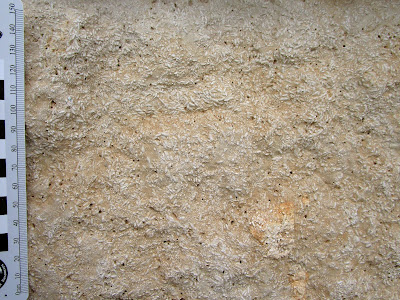Foraminifera are among the most abundant and best known kinds of microfossils (and they aren't exactly confined to the past, either). While it's true that many aren't microscopically microscopic, they're still smaller than is comfortable for practically any human being to study without some kind of magnification at hand. Without such, you'd be stuck squinting at sand-grain-sized things and making such helpful observations as "okay, this one looks like a stack of spheres, and this one is coiled up, and this one is... no, wait, that's an itty-bitty fish vertebra or something." And then there are some that don't require quite as much eye strain to spot.

|
|
Like these: every grain-looking thing is a foram. |
Among these giant microfossils are the fusulinids (or "fusies" if you're lazy like me), the kings of the realm of single-celled organisms during the late Paleozoic. If you can see something the size of a rice grain or a grass seed, you can see a fusulinid. In fact, the comparison will give you the idea of what to look for: fusulinids tend to look like fat, whitish seeds. The Latin word "fusus" means "spindle-shaped", or "something that's long, widest in the middle, and tapering at the ends". There's your fusulinid.

|
|
And there's another, and another... These are getting to around 3 mm
long, or a bit more than a tenth of an inch. (Note also what looks to be
a sliver of a trilobite pygidium near the center.) |
During their heyday, fusulinids could be so abundant that their tests (shells, basically) could more or less make up sediment beds. The resulting rocks are a bit monotonously fossiliferous, as fusulinids tended to look the same on the outside. The interior architecture of chambers is how different species are distinguished, so even though you can see them without needing a microscope, you're going to need one to tell them apart. (Plus the grinding and polishing and all that jazz.) "Why bother?", you may ask. Well, it turns out that the geologically rapid turnover of fusulinid species makes them great biostratigraphic indicators in some places where people are keenly interested in subterranean resources (like the Permian oil fields of Oklahoma and Texas). Know the fusulinids, know the rock; know the rock, know the resources.
The particular examples in these photos come not from in situ outcrops, but building stone. The rock is Cottonwood Limestone used in historic structures in Kansas, and although there are other fossils, the fusulinids are by far the most abundant. The Cottonwood is early Permian in age (Wolfcampian stage in the grand old North American series), so at this point the fusulinids had a few tens of millions of years left to flourish before bowing out at the end of the Permian. According to my old copy of "Invertebrate Fossils" by Moore, Lalicker, and Fischer (1952), this would most likely represent the Pseudoschwagerina zone.

|
|
The stairs are made of forams! (No, it doesn't have the same ring as "The
floor is lava!", but you *are* walking on the bodies of millions of fossilized amoeba things...) |

No comments:
Post a Comment